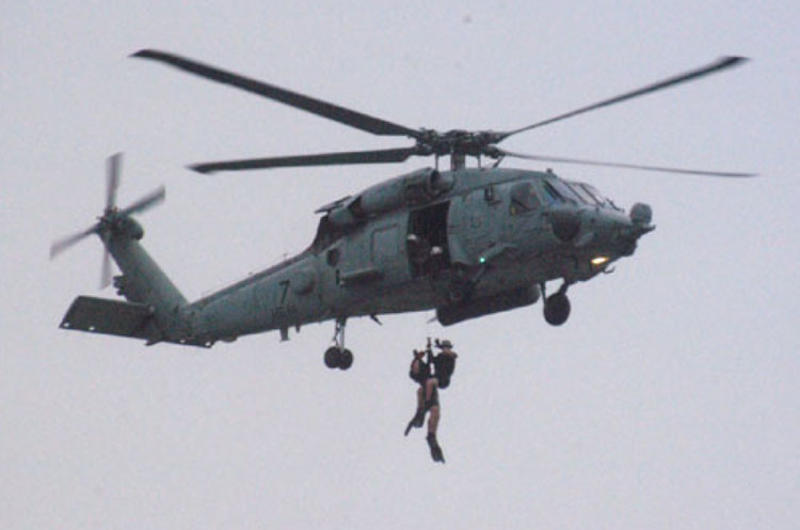AWs are ‘pretty versatile’ sailors

Search-and-rescue swimmers from Atsugi-based HS-14 are hoisted into their helicopter during annual SAR jump training outside Yokosuka Naval Base.
By Juliana Gittler | Stars and Stripes June 14, 2004
YOKOSUKA NAVAL BASE, Japan — Seawater sprays from the helicopter rotor wash as figures drop from the aircraft into the murky water.
The helicopter circles around and returns, dropping a cable from 70 feet. In pairs, the figures slowly attach themselves to the cable and are hoisted to safety.
This search-and-rescue practice helps the swimmers, from Helicopter Anti-submarine Squadron 14, stay ready for the real thing — rescuing an overboard sailor or a pilot from a downed aircraft.
The training is strenuous. But it’s only a piece of one of the Navy’s most unusual jobs — aviation warfare systems operators, or AWs.
Their primary job is hunting submarines.
AWs also conduct search and rescue — on land and sea — serve as gunners, help pilots navigate and assist special operations teams such as SEALs when they’re being transported.
They interact with all three Navy platforms — aircraft, ships and submarines.
“The AWs are pretty versatile,” said Petty Officer 1st Class Darren Hauptman, an AW with HS-14, which is based at Atsugi Naval Air Facility and part of Air Wing 5.
During the Cold War, their main mission was anti-submarine warfare — finding and tracking Soviet subs. But as warfare evolved, so did the job. They began conducting more overland and combat rescues and took on more responsibilities.
Many of them chose this job for the thrill of flying and rescuing.
“It’s the only rate in the Navy where we have to fly all the time,” said Hauptman, who averaged at least 350 hours of flight time last year.
“I saw a helicopter flying around and said, ‘that’s cool,’” recalled Petty Officer 1st Class Marc Ennis of when he joined the Navy. He signed up to become an AW.
“Save lives and fly. You do a lot of things,” added Petty Officer 2nd Class Aaron Beugler.
Becoming an AW, especially a search-and-rescue swimmer, requires demanding training.
AWs leave occupational school at the rank of E-4, a jump above other jobs where sailors graduate as E-2s and E-3s.
Most of their schooling focuses on submarine detection, using electronic systems and technology such as sonic buoys to find subs.
They use two types of Seahawk helicopters, one with more antisubmarine capabilities and another with space for rescues or transporting SEALs.
AWs help pilots navigate over pinpoint locations, so they can land in an enclosed area or on a pinnacle, or hover directly over a rescue swimmer.
“It’s really active for us in the back,” Petty Officer 2nd Class Matt Wittmann.
All of their roles are important but rescue swimming can be the most rewarding — if you get the chance to use it. Only a few AWs ever get the chance to save a life.
Ennis and Beugler rescued a sailor aboard the USS Kitty Hawk earlier this year. Ennis was the swimmer, while Beugler directed the pilot and controlled the cable to hoist swimmer and victim back up.
Not all AWs volunteer to be search-and-rescue swimmers. The program to become a swimmer is taxing. Most who attend the training don’t complete the course.
There are about 2,500 AWs in the Navy and only 1,000 of them do search and rescue.
“It’s more of an extra duty,” Wittmann said.
Keeping up the qualifications is equally stringent. They swim constantly and practice jumps twice a year.
The rescue swimmers also take a physical test each year. They walk 100 yards over obstacles carrying two 50-pound weights, then one mile carrying a 40-pound litter. They do pull-ups then take two swimming tests — 500 meters with gear and 400 meters towing a person.
Swimmers must be able to swim to a victim, ensure they’re not injured and help them into a harness and up to safety. Not everyone who falls overboard wants to be saved and swimmers have encountered aggressive victims who fight back.
“It’s pretty difficult if someone is struggling to stop the rescue,” Wittmann said.
There’s also the fear that they might be too late.
“That’s the first thing in my mind. I don’t want to lose him,” Beugler said.
But despite the work and risks, AWs say they have the most rewarding job. They receive sea pay while embarked on a ship, flight pay and hazardous-duty pay.
They get to fly all the time, and jump in the sea.
“Once you go down in the water you forget about everything else,” Petty Officer 2nd Class Warren Hill said Wednesday. “In a way, you almost get peaceful.”



